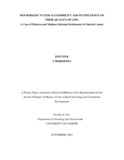| dc.description.abstract | According to NCWSC (2009), only 20% of slum households in Nairobi County have piped
water connections. Most of slum residents buy water in 20 litre jerricans from private vendors
or kiosks with far higher prices than middle and high income households, which typically
have direct connections to the city’s network. The UN (2002) defined water accessibility as
the availability of at least 20 litres of drinking water per person per day with maximum water
hauling round trip of 30 minutes and should not spend more than 5% of their income on
water. Kenya government (2007) set policies that increase access to safe water to the Kenyan
from 60% to 80% by 2015. And water points should be located within 30 minutes round trip
from house with flat rate of Ksh 204 for up to 6 cubic meters water.
The purpose of this research was to determine the achievement of water accessibility in
Mukuru and Mathare slums in terms of international guidelines and Kenya National policies
and residents’ perceptions of water accessibility to their better quality of life. Three villages
in each slum were selected and 192 household heads were sampled. The questionnaire served
as the instrument for collecting data and Microsoft excel programme was used to analyze data.
The two slums reached the goal of national policies to access safe water by indoor tap,
private vendors and kiosks and the respondents in both slums spent an average of 24 litres of
water per day per person. However, over half of them still consumed below 20 liters. They
took an average 2 hours 14 minutes to collect water everyday. Around one third of the
respondents spent over 5% of their income on water and they paid three or more times higher
cost of the flat rate charged by the NCWSC. Water accessibility in Mukuru and Mathare
slums met neither international guidelines nor national policies at all. Almost 80% of the
respondents in both slums perceived realized access to water was crucial issue to improve
their quality of life. Around 60% of respondents expressed their dissatisfaction with the water
supply and their daily water consumption. Kiosks which were prevalent in Mathare provided
better water service to the residents with short physical distance, high hygiene conditions,
low water cost, few price fluctuations and there was high satisfaction of the respondents with
their water supply than was the case with water service by private vendors who were
dominant in Mukuru slum. | en_US |

